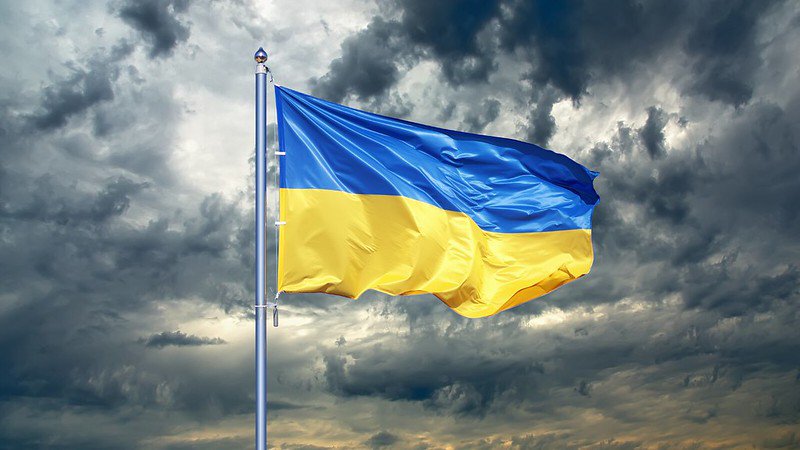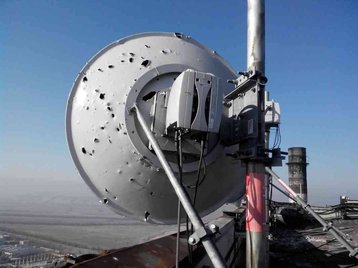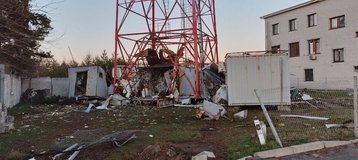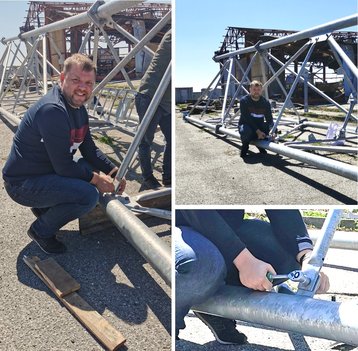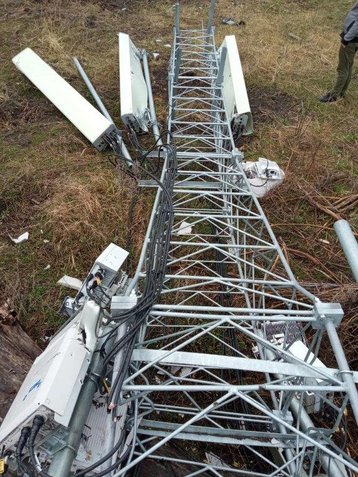"We’ve had more than 10 percent of our sites completely or partially destroyed,” explains Sasha Ananyev, head of the network operation department at Vodafone Ukraine.
That’s roughly 1,400 base stations, and does not include base stations located in Donetsk and Luhansk, areas that have been occupied by Russia since 2014.
Since Russia's unprovoked invasion of Ukraine began in February 2022, CSIS (Center for Strategic and International Studies) estimates that Ukraine's ICT infrastructure has been hit by more than $2 billion worth of damage.
The war has led to the destruction of more than 4,000 base stations across all operators, plus 60,000 kilometers of fiber optic lines, while 12.2 percent of households have lost access to mobile services.
Almost two years on, the country is still stuck rebuilding its telecoms infrastructure.
Vodafone Ukraine estimates that the war has cost the company in the region of 2 billion hryvnia ($54.3 million) as its telecoms infrastructure has been significantly damaged.
Some sites have even been damaged again after being fixed, says the operator.
Cutting the lines
It’s not an uncommon tactic for invaders to attack telecommunications infrastructure during war, using it to quash communications and suppress locals from accessing the wider world.
This happened from the outset of the invasion.
“We could tell by the way our antennas had been shut down that it was deliberately targeted,” says Ananyev, who claims that Russia has stolen millions of dollars worth of its telecoms equipment, and bragged about it on social media.
“It was deliberately shut down. The electric supply stations were also destroyed as the occupiers were afraid they could be used by our army.”
His view was shared by another Ukrainian telecoms provider, Lifecell, which also reported around 10 percent of its base stations being destroyed at its peak, at around 900 sites.
“The first thing the occupiers did in any territory they entered was attack the telecoms infrastructure to deprive Ukrainians of the opportunity to receive news from the Ukrainian mass media, and transmit information about the movement of Russian troops to the Armed Forces of Ukraine,” says Konstantin Sotnikov, manager of the regional operation division, Lifecell Ukraine.
Others have noted that it also stops those left in occupied territory from sharing evidence of war crimes.
Following the occupation of Kherson, connectivity disappeared several times before all operators were shut down in the region at the end of May 2022, Sotnikov says.
“For some time, one Lifecell mobile base station worked in the city, thanks to which the people of Kherson could keep in touch with their relatives and read Ukrainian news. But, later, the occupiers turned it off as well.”
Impact of the sites going down
Damage can vary, with some sites only partially damaged, while others were fully destroyed as a result of heavy shelling.
Vodafone estimates that it can cost between $60,000 to $70,000 if a site is completely damaged. When it is still salvageable, the company believes it spends an average of $40,000 to repair telecoms infrastructure while using its own funds to reconnect these sites.
Lifecell’s Sotnikov explains that to deal with the impact of the war, the operator has had to optimize the network operation in different regions to best maximize 2G connection in more than 400 communities and 3/4G high-speed mobile Internet access services in more than 100 communities in the regions where Ukrainians from combat zones were evacuated.
“To enable the mobile network to meet the growing demand for data services and avoid congestion, Lifecell turned on LTE coverage in the 2,100MHz band with the support of state authorities,” he says.
“But that was not all that needed to be done. The three biggest Ukrainian mobile operators (Lifecell, Vodafone, and Kyivstar) launched national roaming in Ukraine. It means that subscribers can switch to the network of the other operators if it is not possible to use the signal of their mobile operator.”
Even now, the national roaming initiative is still in place. Sotnikov claims that Lifecell hosts up to 300,000 subscribers of other mobile operators on its network daily.
Carrying out repairs safely
When a cell site goes down due to damage, it’s not as simple as just getting an engineer deployed to the site, as it would be in normal circumstances.
During war, the operators had other factors to contend with. Keeping employees safe is prioritized, says Vodafone’s Ananyev.
“So when the base station disappears from our servicing map, it just disappears. When there are war actions in that region, we can't do anything. But when the territory is liberated, and we know it from our government or our army, our engineers go in there to fix it.”
He notes that the army needs to de-mine the area before any repair work can go ahead and then, depending on the damage caused to the site, the frame of work is determined.
In November 2022 in Kherson, Ananyev says his team was able to reconnect the first base station in a week after the Ukrainian forces liberated the city.
Sotnikov told DCD that all of its engineers are provided with bulletproof vests, which are mandatory.
He explains that in Vovchansk, in the Kharkiv region, a team of optical line engineers was hit by an airstrike while carrying out emergency recovery work.
“All the repairmen received a concussion, bruises, trauma, and shrapnel injuries,” he says.
“The base station and the tower itself, which were only recently restored after the occupation, were completely destroyed.”
It’s “impossible to continue repair work in the city,” as it is under constant shelling, he says.
The telco says it attempts to restore telecom sites remotely as much as it possibly can, but will send its engineers to the region where the coverage is down if it is not occupied.
In preparation for the sites going down, Lifecell says that it has repair teams assigned in each region.
“Since the beginning of the full-scale invasion, 90 repair crews throughout Ukraine have been making two to three trips every day to return the network to Ukrainians, sometimes under fire and at risk to the lives of our engineers,” says Sotnikov.
“Often the repair work is complicated and slowed down due to problems with energy supply in the de-occupied territories. We need generators and fuel, which is quite problematic to find in the newly liberated areas, as well as people who will deliver this fuel and regularly refuel the generator.
“The military and residents help us with this. Although the territories have been liberated by the Armed Forces, they are still heavily mined and periodically come under enemy fire.”
Keeping the workforce supported
From a personnel perspective, both Lifecell and Vodafone have noted that some of their employees have been called up to fight in the war.
Fortunately, neither operator has lost their workforce to the conflict.
However, the war has forced many of the population abroad, meaning mobile subscribers have been lost, explained Vodafone. The UN estimates that more than 6.2 million people have fled the country, mostly women and children.
“We have several millions of subscribers that we've lost due to the war, some of them surely relocated to the west of Ukraine, but many of them relocated abroad in the European Union and all over the world.”
Support for Ukraine’s mobile operators has also come in the form of Elon Musk’s SpaceX subsidiary Starlink.
Musk has provided thousands of Starlink terminals to Ukrainians on the frontline, primarily supported by the US and other governments.
Sotnikov says the terminals have been crucial in providing instant communication.
“Starlink solutions allow us to restore the network quickly, especially in those areas where the transport network is seriously damaged and needs time to repair.
“The satellite as a component of the transport network is a revolutionary solution for the Ukrainian market, which during the war allows operators to quickly restore communication in the liberated territories because the usage of Starlink does not depend on the usual Internet infrastructure.”
However, Starlink hasn’t always been reliable, with Ukrainian government officials reporting “catastrophic” outages in October 2022, while it’s also grappled with “signal jamming” issues, according to Musk. Ukrainian forces have also had to deal with Musk’s occasional interference, with the CEO reportedly turning off the service in certain areas.
Supply chain issues
Unsurprisingly, the war has made resupplies a challenge.
“At the beginning of the war, the enemy deprived us of the opportunity to quickly import necessary equipment and machinery for the repair of base stations from abroad,” says Sotnikov, due to the closure of airports and seaports.
Sotnikov also says that, because Lifecell buys its equipment with a foreign currency (USD), the exchange rate increased, further ramping up costs. On top of that, the shortage of fuel only intensified issues.
“We need the fuel for the work of the mobile network repair team and both for refueling the diesel generators to keep the network running during power outages. During terrorist attacks on energy infrastructure, companies’ fuel costs increased significantly.”
Falling behind in the 5G race
While many operators across Europe have focused on launching 5G networks, the same can’t be said for Ukraine.
Speaking to DCD, Stanislav Prybytko, director general of the directorate for mobile broadband for Ukraine's Ministry of Digital Transformation, explains that the war with Russia has stalled the country's 5G goals.
"Our government adopted a plan in 2020, to launch 5G technology in 2022. But due to the full-scale invasion, we changed this," he says.
"It's currently not safe to carry out scientific research, so we need to wait until the end of the war, and only then will it be practical to start. But still, we don't want to waste this time. We are in the process of negotiations with our military services to launch a 5G pilot next year."
Ananyev is confident that the operator will be able to make progress with its 5G development this year.
“If it were not for the war, we would have already introduced the 5G network, because before the war we already held some trials,” he says. “I suppose that we would already have the network in the main cities of Ukraine by now.”
Defiance
Support for the development of its 5G network is also coming from Latvia.
During the 5G Techritory event in October, which was held in Riga, Latvia, Ukraine signed an MoU with the Latvia government, which will see the latter provide support to rebuild Ukraine's telecoms infrastructure.
“For us, the difference between five base stations or 50 base stations is not so big, as we were used to trying to connect up to 500 base stations at the height of this,” Ananyev laughs.
“We recently had severe weather conditions in the south of Ukraine, and their 400 base stations were blacked out here, and it was just peanuts for us to reconnect them all because of our experience.”
As for Lifecell, there have been clear improvements in reducing the number of base stations offline, with the figure currently down to approximately 6.7 percent from above 10 percent.
“Since the beginning of the war, we have built more than 800 new base stations throughout Ukraine,” says Sotnikov.
“Thanks to the construction of new and modernization of existing base stations, 4G communication and mobile Internet have been improved for 542 settlements.”
While the destruction of mobile sites is still a real threat, Lifecell and Vodafone continue to operate in dangerous conditions, to keep their people and forces connected in the face of war, and deliver the latest technology.
The Ministry of Digital Transformation of Ukraine's Prybytko is confident that this moment will pass, and Ukraine will stave off Russia’s invasion, retaining its independence.
“Our estimation on 5G’s full-scale launch will be eight months after our victory,” he says.

